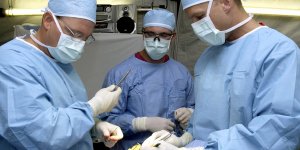Health News
A team from Washington University School of Medicine in St. Louis, previously engineered a scaffold to guide stem cells into cartilage-producing cells. »
Scientists identified a molecule that restores the activity of a dysfunctional enzyme tied to both Gaucher disease and Parkinson’s disease. These findings suggest a new avenue to explore for treating these disorders. »
Researchers have mapped 180 distinct areas in our brain’s outer mantle, or cortex – more than twice the number previously known. »
A study in mice shows for the first time that high-contrast visual stimulation can help damaged retinal neurons regrow optic nerve fibers, otherwise known as retinal ganglion cell axons. »
A recent study revealed biomarker combinations in urine that are unique to prostate cancer and 2 of its stages. The findings suggest a noninvasive approach to diagnosing prostate cancer and assessing tumor progression. »

Researchers found that blood levels of seafood- and plant-based omega-3 fatty acids were associated with a lower risk of dying from heart attacks. »
An epigenomic analysis of rheumatoid arthritis in knee and hip joints revealed unique patterns that suggest disease mechanisms may differ from joint to joint. The findings could open the door to development of more effective, personalized therapies for rheumatoid arthritis. »
Proper maternal folate levels during pregnancy may protect children from a future risk of obesity, especially those born to obese mothers, according to a study. »
Introducing peanut-containing foods during infancy as a peanut allergy prevention strategy does not compromise the duration of breastfeeding or affect children’s growth and nutritional intakes, new findings show. »
Beta-amyloid, a protein implicated in Alzheimer’s disease, appears to help protect mice and worms from infection with bacteria or fungi. The results suggest that Alzheimer’s disease may result from certain infections. If validated, the findings could lead to novel approaches to prevent the disease. »
Rare tumors called pheochromocytomas and paragangliomas may cause the same symptoms as attention deficit hyperactivity disorder (ADHD) in children, leading to inappropriate treatment that could worsen their symptoms and potentially endanger their health. »
A team of scientists investigated antimicrobial gene activation during infection to better understand the body’s immune response to microbes. »
Leisure-time physical activity has many health benefits. In addition to a reduced risk for heart disease, increased physical activity has been associated with a lower risk for colon, breast, and endometrial cancers. »
Researchers found that a healthy person’s skin microbes change remarkably little over time. The stability, however, varies across body sites. »
Researchers determined that microtubules, a type of molecular “strut,” play a key role in regulating contractile function in mouse and rat heart cells. »
Researchers with the National Human Genome Research Institute have collaborated with physicians and medical geneticists around the world to create the Atlas of Human Malformation Syndromes in Diverse Populations. »
The long-held approach to predicting seasonal influenza vaccine effectiveness may need to be revisited, new research suggests. »

Sticking to a healthy diet in the years after pregnancy may reduce the risk of high blood pressure among women who had pregnancy-related (gestational) diabetes. »
The Zika virus surface is similar to that of dengue and related viruses at the near-atomic level, researchers found, but with a notable difference. »
Researchers have sequenced nearly the entire genome of human, mouse and rat Pneumocystis. This organism causes a life-threatening pneumonia in immunosuppressed hosts. »
Researchers designed and tested a system that delivered nanometer-sized particles of a cancer drug to tumors in mice, improving survival. »
A woman is more likely to miscarry if she and her partner drink more than two caffeinated beverages a day during the weeks leading up to conception. »
Higher levels of HDL have been associated with a lower risk of cardiovascular disease. However, pharmaceutical approaches to reduce heart disease risk by raising HDL levels have had disappointing results. »
Study provides evidence for the existence of a non-opioid process in the brain to reduce pain through mindfulness meditation. »
Scientists identified the mechanism behind genetic variations that were linked to schizophrenia in previous genomic studies. »
The benefits of regularly consuming peanut-containing foods early in life to prevent the development of peanut allergy persist even after stopping peanut consumption for one year. »
Exposing babies delivered by C-section to fluids from the mother’s birth canal enriched the babies’ microbes to levels more typical of babies born vaginally. »
A genomic analysis identified 3 genes that contribute to the most common type of glaucoma, raising the total number to 15. »
Among women who had gestational diabetes, breastfeeding was associated with a lower rate of type 2 diabetes for up to 2 years after childbirth. »
A National Institutes of Health study found that non-invasive brain stimulation decreased calorie consumption and increased weight loss in adults who are obese. »
A single variation in the gene for brain-derived neurotrophic factor (BDNF) may influence obesity in children and adults, according to a new study. »
A trio of antibiotics that had become powerless against MRSA decades ago proved effective in infected mice when used together. »
Female mice exposed in utero, or in the womb, to low levels of arsenic through drinking water displayed signs of early puberty and became obese as adults. »
Researchers found genetic variations in the Inuit of Greenland that reflect adaptations to their specific diet and climate. »
The inflammatory eye disorder autoimmune uveitis occurs when a person’s immune system goes awry, attacking proteins in the eye. What spurs this response is a mystery, but now a study on mice suggests that bacteria in the gut may provide a kind of training ground for immune cells to attack the eye. »
Scientists have shown that the passage of molecules through the nucleus of a star-shaped brain cell, called an astrocyte, may play a critical role in health and disease. »
While some research suggests that a diet high in omega-3 fatty acids can protect brain health, a large clinical trial found that omega-3 supplements did not slow cognitive decline in older persons. »

In a recent study, restricting dietary fat led to body fat loss at a rate 68 percent higher than cutting the same number of carbohydrate calories when adults with obesity ate strictly controlled diets. »
Researchers have shown that magnetic resonance imaging can detect the earliest signs of breast cancer recurrence and fast-growing tumors. Their approach detects micrometastases, breakaway tumor cells with the potential to develop into dangerous secondary breast cancer tumors elsewhere in the body. The approach may offer an improved way to detect early recurrence of breast cancer in women and men. »
The liver is unique among organs in its ability to regenerate after being damaged. Exactly how it repairs itself remained a mystery until recently, when researchers from University of California, San Diego (UCSD) School of Medicine, discovered a type of cell in mice essential to the process. The researchers also found similar cells in humans. »
Dietary restriction has been shown in a variety of animal models to have many health benefits. Fasting, in which food isn’t consumed (but water is), represents the extreme form of restriction. Previous studies in animals and people suggested that periodic cycles of fasting may improve certain metabolic and immune functions. »
Researchers at the Washington University School of Medicine, St. Louis, and University of Illinois, Urbana-Champaign, created a remote controlled, next-generation tissue implant that allows neuroscientists to inject drugs and shine lights on neurons deep inside the brains of mice. »
Researchers developed a noninvasive method to detect both early- and late-stage pancreatic cancer. If the findings are confirmed in a larger group, they could lead to routine tests that catch pancreatic tumors early and boost survival rates. »
Researchers have developed a “placenta-on-a-chip” to study the inner workings of the human placenta and its role in pregnancy. The device was designed to imitate, on a micro-level, the structure and function of the placenta and model the transfer of nutrients from mother to fetus. »
Scientists have solved a long-standing mystery about the origin of one of the cell types that make up the ovary. The team also discovered how ovarian cells share information during development of an ovarian follicle, which holds the maturing egg. »
Two drugs already on the market — an antifungal and a steroid — may potentially take on new roles as treatments for multiple sclerosis. These drugs may activate stem cells in the brain to stimulate myelin producing cells and repair white matter, which is damaged in multiple sclerosis. »
HIV, the virus that causes AIDS, attacks and destroys immune cells. Current treatment with antiretroviral therapy helps to prevent the virus from multiplying. But despite advances in treatment, scientists haven’t yet designed a vaccine that protects people from HIV. »
A common over-the-counter allergy drug lowered hepatitis C virus levels in infected mice. »
Using an advanced genetic test, researchers were able to detect diffuse large B-cell lymphoma (DLBCL) in blood serum before it could be seen on CT scans. »
Heredity accounts for up to 35 percent of small intestinal carcinoid, a rare digestive cancer. The researchers examined families with a history of the disease. Because the disease has long been considered randomly occurring rather than inherited, people with a family history are not typically screened. »



